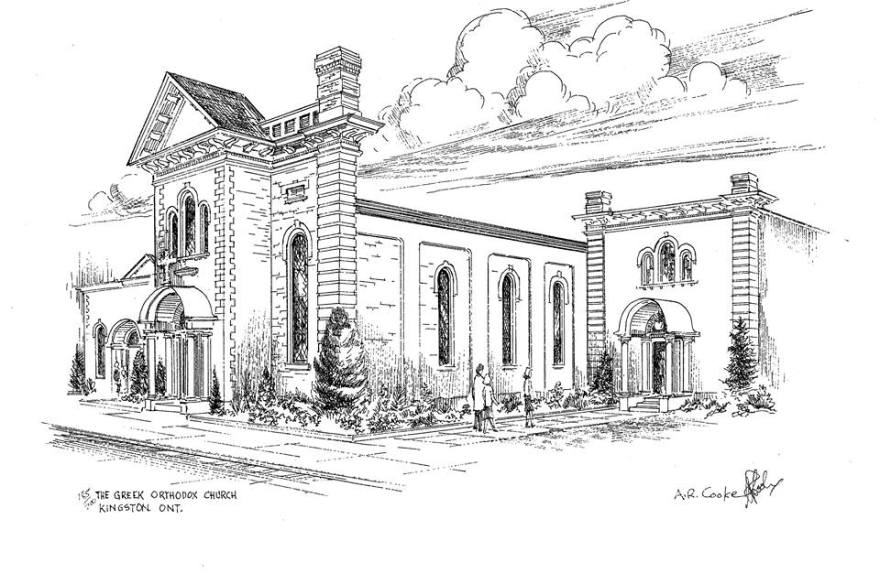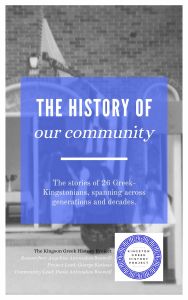Components of this section of our website are also hosted on Queen’s University’s STONES project. Click here to view it.
This is a multi-media tour, including photos, videos, maps, and audio clips. This is by no means meant to present a full picture of our community’s history. We were able to include the perspectives and stories of 26 narrators from the community in this project, and we know many stories have yet to be heard.
This has been written according to data acquired from interviews with our narrators, archives provided by our narrators, external references, and other archival data such as local newspapers. Much of this history is based on the memories of our community members, and while we have tried our best to double-check and cross-reference information for factual accuracy, it cannot be entirely guaranteed. The history of our community in Kingston, as written here, spans from the 1910s until the present day.
Funding for this project was graciously provided by the Kingston Heritage Fund Project Grant. This project was completed for collaboration with Queen’s University Archives, where our archives are stored and our story is displayed on their STONES website. The Kingston Greek History Project is comprised of George Katinas, Paula Antonakos Boswell, and Angeline Antonakos Boswell, all three of whom have dedicated themselves to acquiring the data for this project.
Themes:
Introduction
Immigration Pre-WWII
Immigration Post-WWII
Work and Businesses
The Greek Orthodox Church
The Church as the Center of the Community
Greek Culture Upkeep Among Greek Canadians
Folklore
Weddings, Ceremonies, and our Pre-Church History
Greekhood and the Future of Hellenism
Community Organization
Life Stories
Introduction
Greeks have been in Kingston since the turn of the 20th century. The first Greeks in Kingston consisted of a few close-knit families who held gatherings for holidays and other special occasions, attending church services at St. George’s Cathedral. The Greeks in Kingston would not have their own church, nor receive their charter to become an official Greek Community, until the 1960s. Many were business owners, dominating Kingston’s Princess Street with Greek-owned restaurants, candy shops, and ice cream parlors throughout the 1920s and 30s. Many were involved in the Hellenic organizations of AHEPA and the Daughters of Penelope.
The end of World War II and the end of Greece’s Civil War, accompanied by Canada’s more liberal immigration policies at the time, brought about Canada’s largest wave of Greek immigration in the 1950s-1960s. Kingston saw a large increase in the population of Greeks at this time. With their famous entrepreneurial spirit, many also went on to own businesses – as the typical Greek-Canadian immigration tale goes, many arrived with “nothing in their pocket” and worked their way up to success through hard work and dedication.
Along with the increase in Kingston’s Greek population came its demand for an official community and a church. It was in 1961 that a group of dedicated Greeks in Kingston – including, among others, George Speal, Chris Zakos, Frank Karis, Chris Nikas, and Louis Leos – approached the Bishop in Toronto with a request to organize themselves under their own community charter. That year, the Archbishop Athenagoras visited Kingston to help the Greeks establish their community. Our own church was established in 1963. It had been an old Baptist Church, which the community worked hard to renovate until it was transformed into an Orthodox church. Our church is titled “Koimisis Tis Theotokou Greek Orthodox Church”, and is located at 121 Johnson Street.
Since its establishment, it has hosted Greek School, Sunday School, many weddings, baptisms, holidays, and special occasions, services every Sunday, Greek dance classes, Philoptohos meetings, GOYA (Greek Orthodox Youth Association) meetings, and even Folklore (an important cultural event in Kingston during the 1970s-1990s). Now, our community is comprised of more than 300 families.

This walking tour of our community looks at the following themes: Immigration Pre-WWII, Immigration Post-WWII, Work and Businesses of Greeks in Kingston throughout time, The Greek Orthodox Church, The Church as the Center of the Community (including information on the purchasing and establishment of our church and community), Greek Culture Upkeep Among Greek Canadians (including information about Kingston’s Greek School, Sunday School, and other vehicles for Greek culture), Folklore, Weddings, Ceremonies, and our Pre-Church History (including the use of St. George’s Cathedral in the days before we had a church), Greekhood and the Future of Hellenism (exploring what it means to maintain Greekhood, and exploring fears around its changing future), Community Organization (including information on Philoptohos, AHEPA, Church Council, and Daughters of Penelope, all important organizing bodies within the community), and Life Stories (including family and narrator summaries, and the immigration experience of some women as wives or domestic workers).
Our Narrators
We collected interviews and archives from the following 26 Greek Community members for this project: Afro Ioannidis; Andreas and Cleo Frantzeskos; Fr. Matthew and Catherine Penney; Fr. Chrysostomos Achilleos; Fil Menikefs; George Katinas; Paula Antonakos-Boswell; Glykeria Martou; John Karkoulis; Maria Triada Karkoulis; Manos Tryfonopoulos; Margaret Zakos; Peggy Geracimo; Maria Karis Brousalis; Mike Kanellos; Olga Xenodohidou; Peter Fountas; Spiro and Maureen Sakell; Chris Nikas; Toula Leos; Pandelis and Voula Bettas; and Voula Stathopoulos (not all of whom are photographed below). To hear their full interviews click here.
Do you want to read the full story of our community in a printable PDF format?
Click HERE to Download.

References used:
- “A Hundred Years of Immigration to Canada 1900 – 1999 | Canadian Council for Refugees.” Accessed July 29, 2018. http://ccrweb.ca/en/hundred-years-immigration-canada-1900-1999.
- Alexiou, Nicholas. “Greek Immigration in the United States: A Historical Overview.” Queen’s College. January 2013. Accessed July 29, 2018. http://www.qc.cuny.edu/Academics/Degrees/DSS/Sociology/GreekOralHistory/Pages/Research.aspx.
- “Century Man: The Father Salamis Story.” Accessed July 29, 2018. http://www.whitepinepictures.com/seeds/iii/31/index.html.
- “Century Man: The Father Salamis Story – General History.” Accessed July 29, 2018. http://www.whitepinepictures.com/seeds/iii/31/history4.html.
- Chimbos, Peter, and Carol Agócs. “Kin and Hometown Networks as Support Systems for the Immigration and Settlement of Greek Canadians.” Canadian Ethnic Studies = Etudes Ethniques Au Canada 15, no. 2 (January 1, 1983): 42–56.
- Chimbos, Peter D. “Greek Canadians.” The Canadian Encyclopedia. Accessed July 29, 2018. https://www.thecanadianencyclopedia.ca/en/article/greeks/.
- Chimbos, Peter D. The Canadian Odyssey: The Greek Experience in Canada. McClelland and Stewart, 1980.
- Chimbos, Peter D. “The Changing Organization of Greek Canadian Communities.” International Journal of Comparative Sociology 27, no. 3–4 (1986): 208–216. https://doi.org/10.1163/156854286X00168.
- “Eva Koulos — Beloved Greek Matriarch – SFGate.” Accessed July 29, 2018. https://www.sfgate.com/bayarea/article/Eva-Koulos-beloved-Greek-matriarch-2701629.php.
- Georgas, James, John W. Berry, Alex Shaw, Sophia Christakopoulou, and Kostas Mylonas. “Acculturation of Greek Family Values.” Journal of Cross-Cultural Psychology 27, no. 3 (May 1, 1996): 329–38. https://doi.org/10.1177/0022022196273005.
- “Greek – Library and Archives Canada.” Accessed July 29, 2018. https://www.bac-lac.gc.ca/eng/discover/immigration/history-ethnic-cultural/Pages/greek.aspx.
- Greek News Agenda. “Rethinking Greece: Yiorgos Anagnostou on Greek America, Greek American Studies and the Diasporic Perspective as Syncretism and Hybridity.” Accessed July 29, 2018. http://www.greeknewsagenda.gr/index.php/interviews/rethinking-greece/6104-rethiniking-greece-yiorgos-anagnostou-on-greek-america,-greek-american-studies-and-the-diasporic-prspctive-as-syncretism-and-hybridity.
- Kaketsis, Anastasia. “Perspectives of Greek Immigrant Women and the Education of Their Children in Canada.” ProQuest Dissertations Publishing, 2000. http://search.proquest.com/docview/304593936/?pq-origsite=primo.
- Kassimi, Charalambos Kasimis, Chryssa. “Greece: A History of Migration.” migrationpolicy.org, June 1, 2004. https://www.migrationpolicy.org/article/greece-history-migration.
- Mina, Noula. “Homeland Activism, Public Performance, and the Construction of Identity: An Examination of Greek Canadian Transnationalism, 1900s-1990s,” 2015. https://tspace.library.utoronto.ca/handle/1807/69412
- Mina, Noula. “Taming and Training Greek ‘Peasant Girls’ and the Gendered Politics of Whiteness in Postwar Canada: Canadian Bureaucrats and Immigrant Domestics, 1950s–1960s.” Canadian Historical Review, January 1, 2013. https://doi.org/10.3138/chr.1177.
- Nagata, Judith. “Adaptation and integration of Greek Working Class Immigrants in the City of Toronto, Canada: a Situational Approach.” International Migration Review 4, no. 1 (October 1, 1969): 44–70. https://doi.org/10.1177/019791836900400104.
- “Order-in- Council PC 1931-695, 1931 | Pier 21.” Accessed July 29, 2018. https://pier21.ca/research/immigration-history/order-in-council-pc-1931-695-1931.
- Panagakos, Anastasia. “Citizens of the Trans-Nation: Political Mobilization, Multiculturalism, and Nationalism in the Greek Diaspora.” Diaspora 7, no. 1 (April 1, 1998): 53–74. https://doi.org/10.1353/dsp.1998.0015.
- Tastsoglou, Evangelia. “The Margin at the Centre: Greek Immigrant Women in Ontario.” Canadian Ethnic Studies = Etudes Ethniques Au Canada 29, no. 1 (January 1, 1997): 119–60.
- Ted. (2008, August 25). Retrieved November 3, 2018, from https://bespokebybrouhaha.me/2008/08/25/ted.
- Tessie. (2009, July 7). Retrieved November 3, 2018, from https://bespokebybrouhaha.me/2009/07/06/tessie/





















